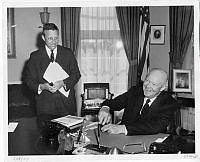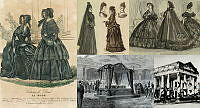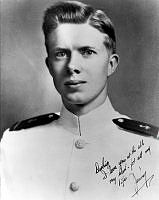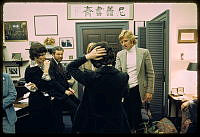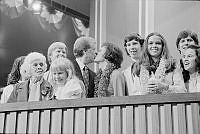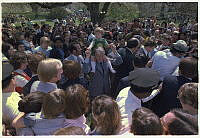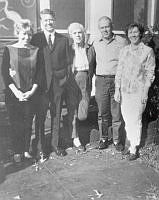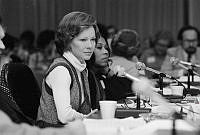Rubenstein Center Scholarship
The Life and Presidency of Benjamin Harrison
The White House Christmas Ornament 2008 Historical Essay
Born in North Bend, Ohio, on August 20, 1833, Benjamin Harrison was the grandson of "Old Tippecanoe," William Henry Harrison, ninth president of the United States. The second of ten children to John and Elizabeth Harrison, Benjamin grew up at The Point, his grandfather's six hundred acre farm near North Bend. His early education included attendance at a nearby one-room schoolhouse. At age 14 Harrison attended Farmer's College in Cincinnati and transferred to Miami University in Oxford, Ohio as a junior. In 1852, he graduated with honors and took up the study of law at a Cincinnati law firm gaining admission to the bar two years later.
While at Farmer's College Harrison met and fell in love with Caroline "Carrie" Lavinia Scott, the daughter of John Scott, a science and math professor and ordained Presbyterian minister. Together they had two children, Russell and Mary.
The couple moved to Indianapolis, where Harrison practiced law and established a successful partnership with William Wallace. He became active in the Republican Party and ran successfully for city attorney of Indianapolis in 1857. During the Civil War, Harrison served as a colonel of the 70th Indiana Volunteer Infantry. His unit guarded railroads in Kentucky and did not see significant action until the battle of Resaca in northwest Georgia in 1864. His troops fought well and Harrison received a brevet promotion to brigadier general.
After the war Harrison returned to Indianapolis to his legal practice, specializing in criminal and divorce cases. His legal skill, military service, and speeches on behalf of Republican causes made him famous throughout Indiana. In 1881, the Republican controlled legislature named him to serve in the United States Senate (popular election of Senators did not begin until 1913).
Nominated for president at the 1888 Republican Convention, Benjamin Harrison conducted one of the first "front porch" campaigns, delivering short speeches to delegations that visited him. The key issue of the election was the tariff, which Harrison pledged to raise if elected. Harrison lost the popular vote, but with the help of a narrow victory in New York won the Electoral College with 233 to 168 votes.
THE HARRISON PRESIDENCY (1889-1893)
Harrison's administration began in a momentous year. The great Oklahoma Land Rush of 1889 opened Indian Territory, while the Johnstown Flood claimed 2,209 lives in Pennsylvania. Loyal to veterans, Harrison signed the Dependent and Disability Pensions Act in 1890, expanding aid to disabled service men, their widows and dependents. He also signed the Sherman Anti-Trust Act, which attempted to protect trade and commerce against "unlawful restraints and monopolies." Harrison lobbied successfully for the Sherman Silver Purchase Act, requiring the government to use silver in its coinage. The redemption of silver dangerously depleted U.S. reserves during the ensuing Panic of 1893 forcing the bill to be repealed.
An avowed protectionist, Harrison favored the passage of the McKinley Tariff of 1890, a bill protecting American corporations with high import duties that resulted in higher consumer prices and lower wages. He approved substantial appropriations bills for internal improvements, expansion of the Navy, conservation of forests resources, and promoted an aggressive foreign policy. He promoted the first Pan American Congress in Washington in 1889, negotiated an American protectorate over the Samoan Islands, and submitted to the Senate a treaty to annex Hawaii. Harrison appointed Frederick Douglass as minister to Haiti and endorsed bills to prevent southern states from denying voting rights to African Americans.
Harrison lost his bid for reelection to Grover Cleveland in 1892. Middle class voters angered by the unpopular McKinley tariff voted Democrat and farmers in the west and south formed a new third party, the Populists, drawing more than a million votes. The Republican Party was lukewarm to his candidacy and any enthusiasm Harrison had for his campaign faded during the fall of 1892 when Mrs. Harrison died in the White House of tuberculosis on October 25. Leaving office a widower, Harrison returned to Indianapolis and eventually married Carrie Harrison's 37-year old former secretary and niece, Mary Scott Dimmick. A dignified elder statesman in retirement, Harrison died in 1901.
"A HOMELIKE ADMINISTRATION"
In 1891, Irwin H. Hoover a youthful employee of the Edison Company was selected to wire the White House with electricity. "Ike" as he was nicknamed, remained on the staff for 42 years. Hoover described the Harrison White House as a "homelike administration" referring to the Harrison's tight knit family and "Hoosier ideas of simplicity." The family routine was like clockwork: an eight o'clock breakfast, a one o'clock lunch, and an early dinner. The president usually worked in the morning and part of the afternoon at his desk or consulted with cabinet members. In good weather Harrison would slip out for strolls or solitary buggy rides over the countryside.
Accommodations were tight in the Harrison White House. Six adults and three children shared the second floor family quarters, where the president and Mrs. Harrison occupied the traditional bedchamber on the southwest corner. Their daughter Mary and her husband James Robert McKee had the bedroom on the northwest corner next to a dressing room converted into nursery for their children Mary and Benjamin McKee who often played on the White House lawn with family pets, including their famous goat, His Whiskers. The press took a special shine to Harrison's two-year old grandson Ben calling him "Baby McKee." Son Russell Harrison, his wife Mary, and daughter Marthena were regular visitors at the White House. The extended family circle also included the Reverend John Scott, age 90, and niece Mary Dimmick.
Mrs. Harrison restricted public visitors to the Entrance Hall and East Room hoping to keep the first floor staterooms private for family use. To ease the overcrowding she began working out a major enlargement of the White House to honor the 100th anniversary of George Washington's inauguration as president of the United States. During much of the nineteenth century the executive offices occupied the east half of the second floor leaving only the west side and central hall as private family space. With the aid of engineer Frederick Owen, the first lady envisioned a magnificent quadrangle complex. Additions included a "Public Art Wing" to the east and an official business wing to the west connected to the original White House by semicircular colonnades. A low, long range of conservatories closed off the south edge of a quadrangle.
Mrs. Harrison's plan foundered in the Congress. Speaker Thomas B. Reed of Maine claimed to have been personally offended by the president passing over his candidate for collector at Portland, Maine. His revenge prevented the bill authorizing the White House expansion to come to the floor for a vote. For the next decade, the subject of a White House expansion interested both presidents and their building commissioners, finally culminating in Congressional approval of the 1902 Theodore Roosevelt restoration that converted the house to modern living. Meanwhile, with the promise of a new house gone, Mrs. Harrison succeeded in making improvements-installing private bathrooms, a new kitchen, electric lights and call bells, and updating all the rooms with fresco and fresh paint.
CHRISTMAS IN THE HARRISON WHITE HOUSE
As chilly as President Harrison may have appeared to people who did not know him up close, friends and associates found him warm and jolly. The diminutive chief executive doted on his grandchildren and went great lengths to amuse them. To the delight of the children, he introduced the first recorded Christmas tree to the White House, on their first Christmas there in 1889. He conferred with the White House gardener Henry Pfister, who, with the "bouquet makers" on his staff, decorated the upstairs family library with ropes of holly and "prince's feather" ferns, accented with springs of mistletoe. Dominating the center of the room was what one observer described as "the most beautiful and perfect tree that could be found in all the country."
Executive clerk William H. Crook who had known the house intimately since Lincoln's time, recalled his first sight of the Harrison tree on Christmas morning: "From the topmost point to the floor it was laden with decorations, with toys innumerable for the children and gifts for the older ones." And Mrs. Harrison had made sure each member of her husband's staff was remembered with a personal token. All of the domestic employees were called in for gifts from under the tree. Of the men, those who were married received a turkey, while single men were given fine gloves; the assumption being that the first would eat at home, while the second would dress up and eat out.
Christmas stands out in White House memory as s special time for the Harrisons. In the holiday celebration, as with many of their other activities, plans and events, Benjamin and Carrie Harrison dramatized the President's House as a family home. And this, for the other roles the White House may play, is the one that touches most powerfully the affections of all Americans.
FURTHER READING:
Benjamin Harrison Papers, Manuscripts Division, Library of Congress.
Crook, William H. Memories of the White House, 1911.
Hoover, Irwin H. 42 Years in the White House, 1934.
Monkman, Betty C. The White House: Its Historic Furnishings and Families, 2000.
Seale, William. The President's House: A History, 2008.
Seale, William. The White House: The History of an American Idea, 2002.
Socolofsky, Homer E. and Allen B. Spetlet. The Presidency of Benjamin Harrison, Lawrence, Kans., 1987.
HISTORIC SITES
Benjamin Harrison Home. 1230 North Delaware Street. Indianapolis, IN 46202
Benjamin Harrison Birthplace / William Henry Harrison Home. Symmes and Washington Avenues. North Bend, OH 45052
Crown Hill Cemetery (Harrison Grave Site). 700 West 38th Street. Indianapolis, IN














